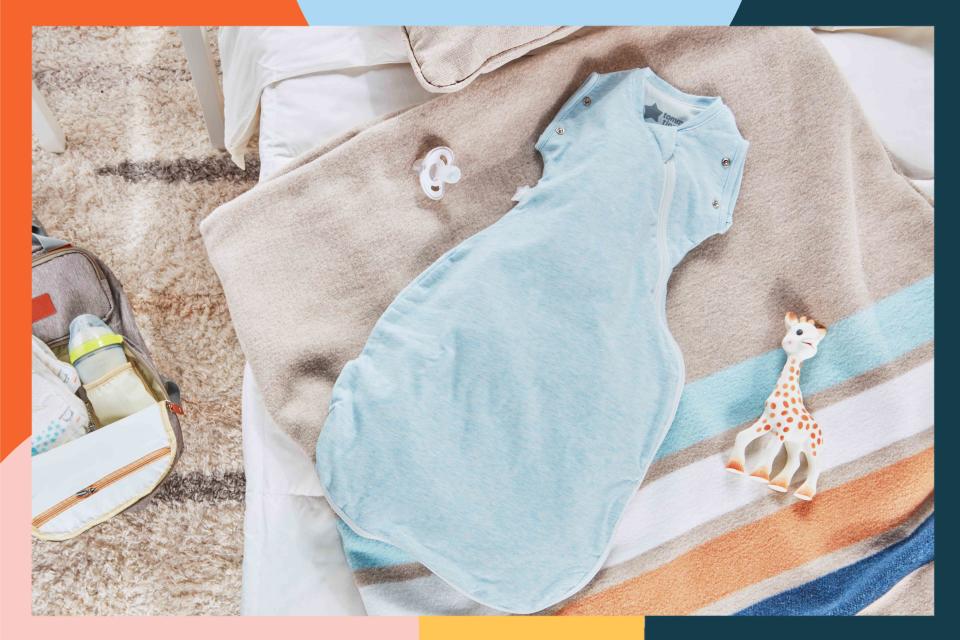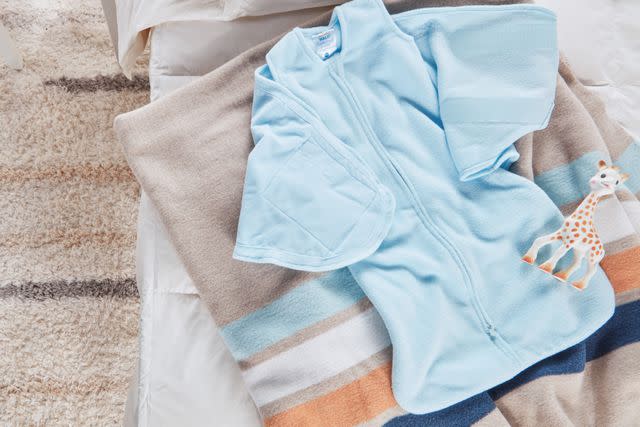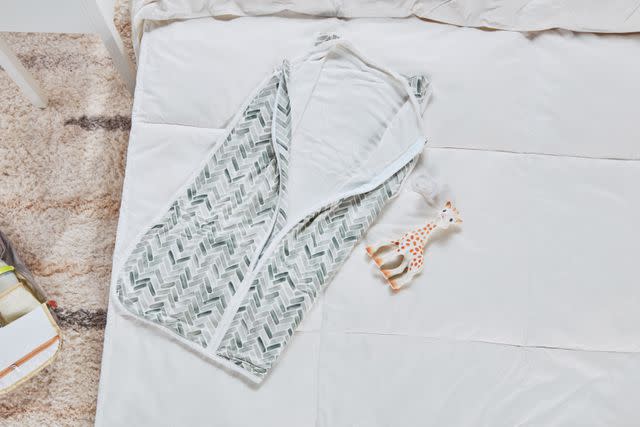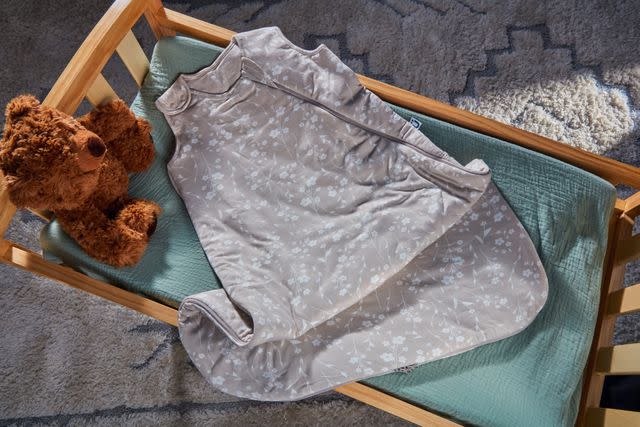The 7 Best Sleep Sacks of 2024, Tested and Reviewed by Parents
Dotdash Meredith and Yahoo Inc. may earn commission or revenue on some items through the links below.
Our overall winner was the Primary Sleep Sack, which earned a perfect score in our tests

People / Jessica Juliao
Sleep is among the most important areas of a baby’s life, and many new parents think they’ve got the hang of getting their baby to sleep through the night during the newborn swaddling stage. But then the baby gets too big for a swaddle and can’t seem to sleep well anymore. Now what?
Thankfully, there’s a product on the market (and Anderson Cooper’s son Wyatt is among its many fans) that helps babies — and parents — get a full night's sleep.
“Sleep sacks help keep babies warm and comfy without the need for loose blankets, which can be a problem if they get unraveled and wrap around a baby’s face," pediatrician and baby sleep expert Dr. Harvey Karp tells PEOPLE. "Sleep sacks help provide a gentle transition to swaddle-free snoozes for babies who spend their first months wrapped during sleep."
Dr. Karp explains that the "sweet spot" for sleep sacks is the first 6-12 months. “The sacks keep babies feeling cozy during the early months, and by 3-4 months — when babies can roll over — parents should use a sack that has arm holes so babies can push up and roll from stomach to back (back sleeping is the safe position for sleeping babies).”
Like most baby products on the market, there’s no shortage of options in the sleep sack department, so PEOPLE put 19 baby sleep sacks to the test in order to find the best brands for our readers — both new parents and gift-givers alike.
Keep reading to discover the best sleep sacks of 2024.
Best Overall: Primary Muslin Sleep Sack

Pros
It has a soft, lightweight cotton fabric, which is great for summer.
The inside zipper is covered by fabric so the baby won't feel it.
It washes well and didn't shrink.
Cons
It runs a bit small.
This sleep sack got a perfect score in our tests, which was used on a toddler several times for sleeping. Said toddler loved the colors and was so excited about his rainbow sleep sack.
Highly comfortable, lightweight, and made of 100 percent cotton, this sleep sack is great for summer. We found it to be very soft against skin but also thin — it's more like a top sheet than a quilt if we were comparing it to adult blankets. The zipper runs the length of the sleep sack, from the bottom up to the neckline, and it's covered in fabric on the inside so the wearer won’t feel the zipper from the inside while rolling around in their sleep, which we thought was a nice touch.
The Primary Sleep Sack washed well in our testing and did not shrink. We found that it ran a bit small, so keep this in mind if your baby is on the longer side when choosing from the four size options. We think the price point is aligned with what we have seen for similar sleep sacks on the market.
Closure: Zipper | Colors: 1 | Material: 100% cotton muslin | Sizes: 0-6, 6-12, 12-18, 18-24

People / Jessica Juliao
Related: The 5 Best Travel Strollers of 2023, Tested and Reviewed by Parents
Best Swaddle: HALO Micro-fleece SleepSack Swaddle

Pros
It can be used as a swaddle or a sleep sack, with the option to keep one or both arms tucked in.
It has handy instructions sewn into the swaddle.
Cons
The micro-fleece fabric may not be the best option in warmer months or climates.
This product is a great option for babies transitioning from swaddle to sleep sack because it’s essentially two products in one. It can be used as a swaddle for younger babies and a sleep sack as they get older, or an in-between sleeper, which keeps one of the baby’s arms tucked in with the other out.
We used this product three times daily on a baby who seemed very happy in this swaddle/sleep sack and slept well while wearing it. There is a silky instruction diagram sewn into the flap of the swaddle for any questions that come up for sleep-deprived caretakers. While the micro-fleece material is warm and cozy, it likely cannot be used year-round on warmer nights or in hot climates.
As the tester was transitioning their daughter from a swaddle to a sleep sack, they started her off with swaddling one arm and leaving one arm out, and this has so far been the only swaddle that she didn’t break out of, thanks to a very big velcro flap that keeps her arm in place. She now uses it as a sleep sack, with both arms out.
Thick and sturdy, it washed well, and we found it to be a great value at its price point — particularly since it’s a product that grows with your child and has so much versatility.
Closure: Zipper and velcro | Colors: 21 | Material: Micro-fleece | Sizes: Preemie, Newborn, Small, Medium

People / Jessica Juliao
Best Stretch: ergoPouch Swaddle Sack 0.2 TOG

Pros
The stretchy, lightweight material is perfect for the swaddle to sleep sack transition.
It comes with a room thermometer and guide.
It holds up well in the wash.
Cons
It may not be warm enough for winter or colder temperatures.
The name of the product perfectly describes it — this sleep sack is like a cocoon. We used this product on a 6-month-old baby, and found that the sack is stretchy and snug, so the baby was able to move around, but it still has that tighter fit, almost like a hug. The baby seemed happy with this sleep sack, with no problems sleeping through the night and plenty of successful naps, as well.
The Ergopouch Cocoon provides the option of keeping the baby’s arms inside the sack, snapping the arm holes closed, or pulling the arms through the holes like a traditional sleep sack. The snug fit is similar to a swaddle and will help control sudden movements, but also is stretchy enough to allow the baby to be comfortable as they start to move around. We loved a multipurpose use of this product that will grow with your baby.
Closure: Zipper | Colors: Sage, Grey, Berry, Night Sky | Material: 95% organic cotton, 5% elastane | Sizes: Newborn, 0-3, 3-6, 6-12
Best with Zipper: Copper Pearl Sleep Bag

Pros
It has an incredibly soft jersey material.
It's simple and easy to use, down to the care instructions printed on the outside.
It unzips from the bottom, making it easy to change diapers.
Cons
It has a higher price point than most of our other winners.
It's likely too warm for summer months or hotter climates.
Of all the sleep sacks we tested, we found this one to be one of the softest with its jersey fabric. Boasting a medium weight and three-layer design, the Copper Pearl Sleep Bag is a great choice for fall, winter, and spring, though likely a bit heavy for summer. The zipper has a protective layer of fabric on the inside to keep the baby comfortable, and it unzips from the bottom for less disruptive diaper changes. Care instructions printed on the outside makes laundry a breeze.
The super-soft material got even softer after washing, and we loved its versatility. New parents don’t need finicky baby gear — this sleep sack is soft, uncomplicated, and is designed for ages 0-6 months, so you’ll get extra time out of it versus the sleep sacks only sized for 0-3 months.
Closure: Zipper | Colors: 11 prints | Material: Polyester/rayon blend | Sizes: 0-6 months

People / Jessica Juliao
Best Spacious: baby deedee Sleep Nest Warm Baby Sleeping Bag

Pros
It's cozy and cuddly, like a quilt for a baby.
It's built to last and for many months of wear in each size.
It snaps on shoulder for easy dressing.
Cons
It's likely too warm for summer months or hotter climates.
We tested this sleep sack on a 6-month-old baby, who slept great in the Deedee sleeping bag for naps and overnight. This is the closest to a baby blanket that we have come across — it is very cozy and warm without being too hot.
The snaps on the shoulders are a great design feature, as you don’t need to contort a baby’s arms to get them inside the sleep sack. Instead, you just slide the baby inside and secure the snaps over the shoulders. It’s a great size with extra length at the bottom for little sleepers who prefer a frog-like pose, or just prefer some extra room while sleeping. This is a nice large size, with a lot of room to grow.
Closure: Zipper and snaps | Colors: 8 | Material: 100% cotton shell, 100% polyester filling | Sizes: 0-6, 6-18, 18-26 months

People / Jessica Juliao
Best Bamboo: Gunamuna Sleep Sack

Pros
It has a cloud-like bamboo material.
The zip-around design on the bottom makes for easy diaper changes.
Cons
It's likely too warm for summer months or hotter climates.
It's pricier than many others we tested.
We (and the baby) had nothing but raves for this sleep sack. Out of the five sleep sacks this baby had slept in, their mom said this one was the coziest, thanks to the bamboo fabric that feels like sleeping on a cloud. It's not too tight around the neck or arms, allowing ample room for the baby to move their legs around.
The zipper goes around the bottom of the sleep sack for the easiest diaper changes possible, plus snaps on one shoulder for easy on and off. After several washes, it held up well in testing. The mom is actually planning on sewing the sleep sack into a blanket once they grow out of it, so they can continue to cuddle with it.
While not a budget option, it’s made with quality material, is incredibly warm and cozy, and seems durable enough to last a long time.
Closure: Zipper, shoulder snaps | Colors: 22 | Material: Bamboo rayon | Sizes: 3-9, 9-18, 18-24, 24-36 months

People / Tamara Staples
Best Investment: Little Giraffe Stretch Chenille Dreamsack

Pros
It's made of the coziest chenille fabric.
It's sturdy and washes well while maintaining its delicate feel.
Cons
It has the highest price point of all our winners.
Its snaps are quite strong — we would have preferred a full-length zipper.
The 6-month-old baby testing this sleep sack during her naps appeared to be cozy and comfortable in it, thanks to the coziest chenille fabric that feels like a wearable blanket.
The sleep sack is well-made and very sturdy, maintains its softness after washing. We were afraid the chenille would look matted after the wash, but that didn't happen. This option comes equipped with a zipper down the front and four snaps on top, and the latter was the only issue we had when testing this sleep sack. We thought it would make more sense if the zipper just continued to the top; since the snaps are so strong, it was sometimes easier just to leave them undone.
While this is on the higher end for a sleep sack, we feel like it's luxurious enough that it’s worth the splurge.
Closure: Zipper and snaps | Colors: Pink, Blue, Cream | Material: 100% polymicrofiber | Sizes: 0-6 months

People / Jessica Juliao
Things to Consider Before Buying Baby Sleep Sacks
Size
What size to buy all depends on your baby’s age and sleeping stage. The bigger your baby, the more useful it is to have extra length at the end of a sleep sack for froggy-style sleepers, as well as for safety once they start standing. “As a bonus, a bigger sleep sack makes it harder for infants to climb out of their crib and fall,” says pediatrician Dr. Harvey Karp.
Pricing
As with many baby products, the more features a sleep sack has, the more the price point will go up. Dual purpose swaddle/sleep sacks (like the Halo Micro-Fleece Sleepsack Swaddle and the ErgoPouch Baby Sleep Sack) tend to have a higher price point, as do those with luxurious materials, like the Little Giraffe Dreamsack made with chenille.
Safety and Development
“I like sacks with lots of room in the hip so babies can frog-leg their hips wide open — that’s the safest for babies,” says Dr. Karp. “And you’ll want to make sure that your little one’s sleep sack is free of any would-be choking or strangulation hazards, like loose ribbons or buttons.”
Material
Sleep sacks come in an array of materials, the most popular being a cotton or cotton blend. You can look for organic materials, too, especially if your baby has sensitive skin. “I’m also a fan of 100 percent organic materials for babies, which is super soft on a baby’s delicate skin,” says Dr. Karp.
Comfort
"The size and the weight of the sleep sack are the most important factors for ensuring it’s effective, while keeping the baby comfortable,” says Megan Pinckney Rutherford of Shades of Pinck. “Also be sure to prioritize the design of the zipper cover — the fabric that’s used to enclose the zipper from making contact with the baby.”

People / Jessica Juliao
How We Tested
Our PEOPLE team evaluated 19 sleep sacks, using them on our own babies and toddlers, washing them based on the care instructions, and inspecting every inch of the fabric and features. We scored each product on a 1-5 scale against four categories: comfort, ease of use, durability, and overall value.
These scores were considered along with the commentary about each product in determining our winners. Fabric, care instructions, and size/weight limits were factored in to the evaluations, as well. The scores with the highest averages made it to this list of PEOPLE winners.
Frequently Asked Questions
Why use a sleep sack for older babies?
“I love that they’re a safe way to provide warmth in the crib and an effective way to cue a baby’s brain that sleep is coming,” Cara Dumaplin of Taking Cara Babies tells PEOPLE. “We also know that little ones are often active sleepers. A sleep sack stays on no matter how much they roll around during sleep, keeping them comfortable and warm all night long.”
Pinckney Rutherford agrees. “Not only are sleep sacks a great way to keep babies warm at night, but they also confine the legs of curious older babies that would love any opportunity to try to climb their crib," she adds.
What are the best ages for sleep sacks?
“A great time to start using a sleep sack is when your baby shows signs of rolling and it’s time to transition from the swaddle," says Dumaplin. "I recommend continuing to use them until your little one is ready to transition to the toddler bed. This makes them a great choice from about 4 months to nearly 4 years.”
How do you choose a safe sleep sack?
Dumaplin advises to look at the TOG rating for sleep sacks, which stands for thermal overall grade. “Sleep sacks are safe when they are the appropriate TOG rating or thickness for the temperature of the room and when they fit properly, " says Dumaplin.
"It basically indicates how warm your sleep sack is going to be. I like to think of it in terms of a sheet (.5), blanket (1.0), and a heavy comforter (2.5). Most company websites even give temperature range recommendations to go with their TOG ratings. When you’re shopping, see what you think would be best for your house, your climate, and your baby." Take into account your nursery temperature and any seasonality differences.
How do you know if a sleep sack is a good fit?
Dumaplin recommends looking for three things when it comes to sleep sack fit. “First, be sure that little legs, hips, and feet can move freely," she says. "Second, you want to be sure that the neck of the sleep sack fits securely, preventing it from coming up over the nose or mouth. And finally, ensure that the arm holes are not so loose that arms can sneak into the body of the sleep sack."
Why Trust PEOPLE
In compiling this list of best baby sleep sacks, freelance writer and editor Rennie Dyball drew on the experiences of our team of product testers, countless online user reviews, and interviews with Dr. Harvey Karp, pediatrician and baby sleep expert, and Cara Dumaplin, founder of Taking Cara Babies.
Meet Our Experts
Dr. Harvey Karp is a pediatrician, child development and baby sleep expert. He is on faculty at University of Southern California School of Medicine and is a fellow of the American Academy of Pediatrics (AAP).
Cara Dumaplin is a pediatric nurse and the founder of Taking Cara Babies — a resource for parents to help with an assortment of childcare concerns such as newborn sleep.
What Is People Tested?
We created the PEOPLE Tested seal of approval to help you find the very best products for your life. We use our unique methodology to test products in three labs across the country and with our network of home testers to determine their effectiveness, durability, ease of use, and so much more. Based on the results, we rate and recommend products so you can find the right one for your needs.
But we don’t stop there: We also regularly re-review the categories in which we’ve awarded the PEOPLE Tested seal of approval — because the best product of today might not be the best of tomorrow. And by the way, companies can never buy our recommendation: Their products must earn it, fair and square.
In short, PEOPLE Tested provides recommendations you can trust — every day, every purchase.
Up Next: The 8 Best Double Strollers of 2023, Tested and Reviewed
For more People news, make sure to sign up for our newsletter!
Read the original article on People.

